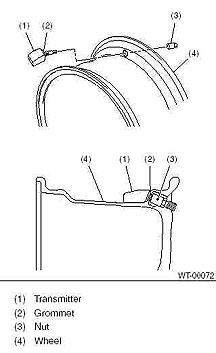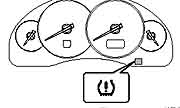How the Subaru Tire Pressure
Monitoring System TPMS works
The
Subaru Tire Pressure Monitoring System (TPMS)
an unofficial information
page to help you understand the tire pressure monitoring system
US Government (NHTSA)
Safety Regulations require all new 4-wheeled vehicles weighing 10,000
pounds or less to be equipped with a tire pressure monitoring system detecting
25% drop in tire pressure by the 2008 model year. A TPMS was required by
Congress in the 'Transportation Recall Enhancement, Accountability, and
Documentation (TREAD) Act' of 2000.
Quick note -
after adding air to tires please drive the car app 5 miles to give the
sensors time to reset. The monitors will need to be re-synced when tires
or wheels are replaced.
what
models is it in - how it works
- inflating - cold
temperature - replacing a monitor
-
using nitrogen - wheel and valve images
- warning light

Subaru tire pressure monitor
information sticker on 2010 models
****
Please
read- this unofficial independent Subaru research
site by Joe Spitz is designed to help you learn about Subarus. It is not
sponsored, authorized, supported or approved by Subaru or any dealer,
and is not connected to or affiliated with, any dealer. Always contact
your local dealer.
Inspect any vehicle prior to purchasing. Information subject to change,
correction, updating. contact
****
All information and formatting
© J Spitz who is responsible for content. Always check with your local
dealer-mechanic. Unauthorized reproduction, copying or use prohibited.
thanks for visiting. you are here: http://www.cars101.com/subaru/tiremonitor.html v 11.11.12
|
Research-
Homepage
I Subaru-speak?
terms I Warranties
I safety:
airbags, child seats
Buy a Subaru-
Subaru
sales in Seattle I Current
Interest rates, rebates I Classifieds,
Forum I Sitemap
I contact
**********************************************************
Updated April 2012
If the car is supposed to have monitors, if it came with monitors, a tire/wheel dealer is required to install them.
That means either buy monitors or remove them from other wheels and install them.
The National Highway Safety Administration (NHTSA), a division of the
U.S. Department of Transportation, recently clarified provision 49
U.S.C. 30122(b) within the Motor Vehicle Safety Act of 2010.
The
provision exactly states:
A manufacturer, distributor, dealer, or motor vehicle repair business
may not knowingly make inoperative any part of a device or element of
design installed on or in a motor vehicle or motor vehicle equipment in
compliance with an applicable motor vehicle safety standard prescribed
under this chapter unless the manufacturer, distributor, dealer, or
repair business reasonably believes the vehicle or equipment will not be
used (except for testing or a similar purpose during maintenance or
repair) when the device or element is inoperative.
The NHTSA further clarified this provision in relation to TPMS in a
letter to the Tire Industry Association dated November 22, 2011. In this
letter the NHTSA presents the following response to a scenario
presented by the TIA:
Scenario: If a motorist purchases a set of aftermarket winter tires
and wheels and declines to purchase new TPMS sensors, does the service
provider violate 49 USC 30122(b) because they would be installing
assemblies that knowingly make the system inoperative?
NHTSB response: In this scenario, we assume that the vehicle has
functioning TPMS system at the time he or she purchases aftermarket tires
and wheels. In that case, a service provider would violate the “make
inoperative” prohibition of 49 USC 30122(b) by installing new tires
and wheels that do not have a functioning TPMS system. To avoid a “make
inoperative” violation, the service provider would need to decline to
install the new tires and rims, use the TPMS sensors from the original
wheels (if they are compatible), or convince the motorist to purchase
new TPMS sensors and ensure that the sensors aer properly integrated
with the vehicle’s TPMS system.
TPMS is standard on the following
Subarus
Outback
All 2008 and newer Outback
2007: all except
Basic
2006 LL Bean, VDC,
3.0R sedan
2005 LL Bean, VDC,
3.0R sedan |
Legacy
All 2008 and newer Legacy
2007 GT
2006 GT |
Forester
All 2008 and newer Foresters
2007 and before:
none |
WRX STI
all since 2088
|
Impreza
All 2008 and newer Imprezas
2007 and before:
none |
BRZ
all since 2012 models
|
Crosstrek
all since 2012 model
|
Tribeca
all since 2006
|
top
How it works:
When the car is turned on
the warning light on the dashboard will come on for
about 2 seconds. This is normal.
If the light flashes (3
seconds off, 1 second on), that indicates a problem with the system. Contact
your dealer.
Each sensor has an separate
ID code. When the vehicle goes 7-20 mph, a roll switch inside the sensor
turns on and the sensor starts to take measurements every 30 seconds, and
sends the results about once a minute to a receiver module under the carpet
by the drver's door. The sensors are off when there is no motion (or 15
minutes after stopping).
When a low tire (app 26-27psi)
is detected a warning light in the dashboard turns
on. The warning light turns on, it does not flash.
The light does not indicate
which tire is low, so please check all tires.
A blow-out won't show up
right away.
When the vehicle stops moving
for 15 minutes, the sensor enters 'sleep' or off mode to save battery life.
WHERE? A transmitter
with a tire pressure sensor is located inside the
each tire's air valve stem. It is designed to detect
low pressure only (not high or over-inflated).
The sensor contains a battery.
Battery life is 10 years or 100,000 miles. When the battery fails the sensor
must be replaced.
top
Inflating and Adjusting
tire pressure
Be sure to let the tires
cool. After adjusting the pressure, drive the car at least 20 mph (32 km/h)
to start the TPMS. If a light was on due to low pressure and the pressure
is now normal, the warning light should go off after driving for a few
minutes. When a spare or a wheel is replaced without the original pressure
sensor being transferred, the low tire pressure warning light will flash.
This indicates the TPMS is unable to monitor all four road wheels.
Contact your dealer as soon as possible for sensor replacement or system
resetting. Do not inject any aerosol tire sealant in the tires because
it will damage the sensor, do not place metal film or any metal parts under
the driver's seat because this may effect the signal from the sensors.
cold temperatures?
cold weather may cause the air tire pressure to drop so the warning light
comes on.
This is normal and tire
pressure should be checked and corrected seasonally.
When checking and adjusting
tire pressure inside when it is in cold or winter outside, the difference
between the indoor and outdoor temperature is large. This means that in
cold air, the tire pressure may drop and the warning light come on. To
avoid this, when inside, inflate the tire slightly more considering the
difference between inside and outside temperatures. Or use nitrogen
which is less sensitive to cold or hot outside temperatures.
top
Replace a wheel or use
the spare? When you replace the wheel or use the spare tire without
the original pressure sensor/transmitter being transferred, the low tire
pressure warning light will flash. It needs all 4 sensors feeding it information.
Rotation? The system
doesn't know which tire is where so there's no problem with rotations.
The dashboard warning light only indicates a low tire but not which tire
is low so you have to check all 4.
Parking Try
to make sure the tires aren't pressing hard against the curb when you park.
FLAT repair using
a can of pressurized tire repair sealant will clog the sensor and it will
have to be replaced
To reset drive the
car app 5 miles after correcting for low pressure.
Tire Pressure Monitor
re-set tool: To reset the system you'll need a small handheld computer.
Needs to be re-synced whenever tires or wheels are replaced.
These are available from
Subaru at https://subaru.spx.com/Home.aspx,
or try aftermarket for less money
Nitrogen in tires -
Some dealers are offering Nitrogen as an alternative to inflating tires
with normal outside air. Nitrogen maintains tire pressure better than normal
air which leaks out over time, and is less sensitive to cold outside temperatures.
As a result, Nitrogen minimizes the Tire Pressure Monitoring light coming
on.
And because it maintains
tire pressure better and is less sensitive to hot and cold, nitrogen can
improve economy, increase tire life, and might be safer because the tires
are less likely to blow-out when driven at high speeds for a long distance,
or on hot roads.
Nitrogen has been used by
Nascar, Formula One, the Tour de France and the military for years.
Mixing air and nitrogen.
Don't put normal air in a tire with nitrogen because you will lose the
nitrogen benefit, but it's not dangerous.
The downside to Nitrogen
is that you might have to pay for it (but air is free).
top
wheel and valve images
top

diagram of the wheel
&
sensor/air valve stem |

the sensor in the
wheel is part of the normal air valve stem that
goes through the side
these images © Subaru
of America
|
warning light

this warning light on the
dashboard
goes on when the car is
started, or when it senses a problem with inflation (steady on), or with
the system itself (flashing).
Note: example only, the
light might not be in this location on the dashboard.
This unoffical research page
is by Joe Spitz for information only not for mechanical repair
contact your dealer
or mechanic for any repairs or any technical questions or issues.
Thank you
top

